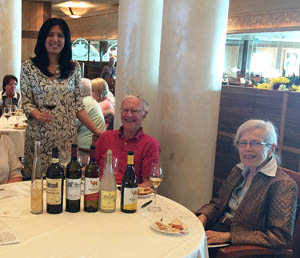
While on the Queen Mary 2 for a world cruise we had a unique opportunity to attend an on board wine tasting of Chinese wines the ship was going to add to their wine list. Having had a few wines when we were in China a several years ago we jumped at the chance to try these wines especially since two of them were in the $100 price range. Our past experience with Chinese wines was limited and only included four or five different wines served in fairly high end restaurants. From that small sampling we were so disappointed with the local wine we switched to Chinese beer while we were in China. This tasting gave us a whole new opportunity to sample what should be good Chinese wines.
Winery/Producer: Changyu Wine Company, with six wineries in China is the countries largest wine producer. The winery was founded in 1892 by a Chinese diplomat and an
Austrian viticulturist when they imported more than 500,000 cuttings from the United States and Europe. Today Changyu is an internationally owned company and is producing 25% of China’s domestic wine market.
Appellation: The six wines we tasted were from four different Changyu Winery locations in China:
 Changyu Pioneer.
Changyu Pioneer.Chardonnay/Riesling, Zuishixian, Yantai 2012 ($45)
Cabernet Sauvignon, Zuishixian, Yanti 2012 ($45)
 Chateau Changyu AFIP
Chateau Changyu AFIP
Chardonnay, Yantai 2011 ($98)
Cabernet Sauvignon, Yantai 2009 ($98)
 Chateau Changyu Moser XV
Chateau Changyu Moser XV
Moser Family Cabernet Sauvignon, Ningxia 2010 ($70)
 Chateau Changyu Golden Valley
Chateau Changyu Golden Valley
Gold Diamond Icewine Vidal 2009 ($75)
Tasting Room and Location: The Britannia Restaurant, on board the Queen Mary 2.
Tasting Price: $40/person
Comments:
 Chardonnay/Riesling, Zuishixian, Yantai 2012. Clear, almost colorless. Mild sweet aromas, a somewhat creamy mouth-feel and crisp, somewhat bitter taste with sweet undertones. Although there may only be a small amount of Riesling in the wine the sweetness in a Chardonnay was not a positive taste.
Chardonnay/Riesling, Zuishixian, Yantai 2012. Clear, almost colorless. Mild sweet aromas, a somewhat creamy mouth-feel and crisp, somewhat bitter taste with sweet undertones. Although there may only be a small amount of Riesling in the wine the sweetness in a Chardonnay was not a positive taste.
 Chardonnay, Yantai 2011. Clear, light wheat straw color and an unpleasant aroma of spoiled meat. Lots of Vanilla and oak in the taste but it finished with lots of crisp acidity that was a tad harsh.
Chardonnay, Yantai 2011. Clear, light wheat straw color and an unpleasant aroma of spoiled meat. Lots of Vanilla and oak in the taste but it finished with lots of crisp acidity that was a tad harsh.
 Cabernet Sauvignon, Zuishixian, Yantai 2012. Clear, dark purple color with musty sharp aromas. Strong dry mouth puckering taste with ripe current and fruit flavors that continued through the finish. The taste could be described as unpleasant when compared side-by-side to the other two Cabernets.
Cabernet Sauvignon, Zuishixian, Yantai 2012. Clear, dark purple color with musty sharp aromas. Strong dry mouth puckering taste with ripe current and fruit flavors that continued through the finish. The taste could be described as unpleasant when compared side-by-side to the other two Cabernets.
 Moser Family Cabernet Sauvignon, Ningxia 2010. Dense dark purple color with strong moldy and petroleum aromas. Somewhat smooth dark fruit and mushroom taste that is dominated by the dry acidic mouth-feel that follows through the finish. More characteristic of Cabernet and the most drinkable of the three Cabernets when tasted side-by-side. Eating cheddar cheese greatly improved the taste of this wine, while it didn’t for the other two Cabernets.
Moser Family Cabernet Sauvignon, Ningxia 2010. Dense dark purple color with strong moldy and petroleum aromas. Somewhat smooth dark fruit and mushroom taste that is dominated by the dry acidic mouth-feel that follows through the finish. More characteristic of Cabernet and the most drinkable of the three Cabernets when tasted side-by-side. Eating cheddar cheese greatly improved the taste of this wine, while it didn’t for the other two Cabernets.
 Cabernet Sauvignon, Yantai 2009. Dark purple color. Unusual sweet fruit aromas, dry mouth puckering cherry taste and a medium-long dry finish. The wine was not oxidized, but it had “off” flavored damp earth overtones that made it unpleasant.
Cabernet Sauvignon, Yantai 2009. Dark purple color. Unusual sweet fruit aromas, dry mouth puckering cherry taste and a medium-long dry finish. The wine was not oxidized, but it had “off” flavored damp earth overtones that made it unpleasant.
 Gold Diamond Icewine Vidal 2009. Dark orange color. Sweet, sweet, sweet says it all with this wine. A heavy sweet aroma, concentrated thick syrupy mouth-feel and a stainless steel or medicinal taste that goes on and on in the finish. On this wine we have a split decision, Vicky put this in the “drinkable” category and I took one sip and couldn’t finish my taste…and it’s not often that I don’t finish a taste.
Gold Diamond Icewine Vidal 2009. Dark orange color. Sweet, sweet, sweet says it all with this wine. A heavy sweet aroma, concentrated thick syrupy mouth-feel and a stainless steel or medicinal taste that goes on and on in the finish. On this wine we have a split decision, Vicky put this in the “drinkable” category and I took one sip and couldn’t finish my taste…and it’s not often that I don’t finish a taste.
In a nut-shell this was an EXCELLENT tasting…lots of fun and a real hoot. The opportunity to sample six Chinese wines and hear the background of each wine from the Export Manager of the Changyu Winery, Miss Tan Shaoyun, clearly added to the information content of the tasting. Unfortunately, at the price these wines are being offered on the ship they may be a VERY difficult sell. In the ship restaurants they are competing with wines from around the world that are in most cases better quality than these Chinese offerings at Cunard’s price points. At lower prices these Chinese wines could be competitive with many mass produced wines from around the world…and, maybe in a wine store they would be more competitively priced.
 | 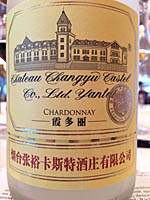 | 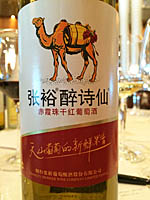 |
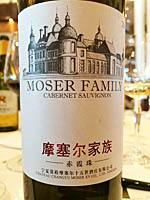 | 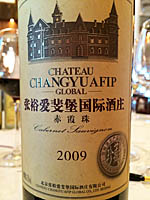 | 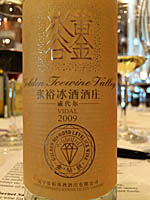 |